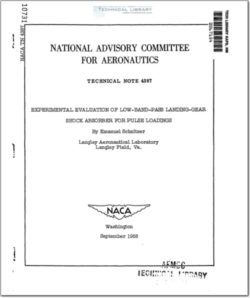NACA-TN-4387

- Version
- 113 Downloads
- 2.34 MB File Size
- 1 File Count
- March 24, 2016 Create Date
- March 24, 2016 Last Updated
Experimental Evaluation of Low-Band-Pass Landing-Gear Shock Absorber for Pulse Loadings

An experimental investigation.was conducted to determine the prac—
ticality of constructing a low—band—pass landing—gear shock absorber V
and to evaluate its effectiveness in reducing rapidly applied loads. i
The band-pass principle was first introduced in NACA Technical Note 3805
from a theoretical point of View. For the experimental investigation
presented herein, a low-band-pass shock strut was designed, constructed,
and tested in conjunction with a high-pressure tire which was used in
order to develop and transmit steep pulses. Taxiing runs were made
over individual bumps to determine the strut pulse rate response and
over consecutive closely spaced bumps to determine strut recycling
characteristics. Duplicate tests were made with a comparable shock
absorber having a fixed main orifice area. Design details are pre-
sented for the shock struts tested and also for a proposed band-pass
vibration absorber. The loads for the low—band—pass strut for single
rapidly applied pulses were 50 percent of the loads for the fixed—orifice
strut whereas for cyclic loading the low-band-pass loads were less than
25 percent of the fixed-orifice strut loads. Smaller reductions were
achieved for rapidly applied pulses superposed on slowly applied pulses.
There was no attempt in this investigation to develop an optimum control
unit to minimize loads for both single and multiple superposed pulses
over the entire spectrum of load application rates. The load reductions
achieved, however, were accomplished by the addition of a 1%u—pound con-
trol unit to the shock strut of a 5,000—pound airplane.
This paper deals with the experimental evaluation of the band—pass
principle as applied to a landing—gear oleo-pneumatic shock absorber
hereinafter termed "shock stru ." The application of this principle
was originally considered from a theoretical point of view in refer-
ence l as a means of overcoming some of the limitations of conventional
shock absorbers. For example, in the case of aircraft operation on a
land or water runway of a given rOughness, as the aircraft speed increases,
the rate of rise of the tire bottom over the bump increases with a
corresponding increase of the load application rate.
| File | Action |
|---|---|
| naca-tn-4387 Experimental Evaluation of Low-Band-Pass Landing-Gear Shock Absorber for Pulse Loadings.pdf | Download |

Comment On This Post